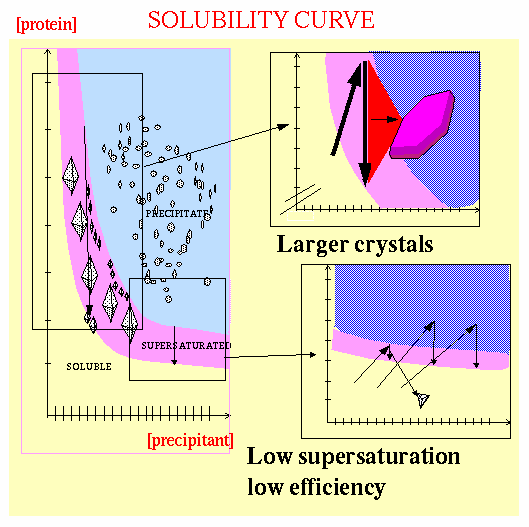The Reverse Screening Technique:
The method is referred to as reverse screening because the first step consists of making the best guess of what are likely crystallization conditions rather than embarking on a comprehensive screen.
This can be done by analysizing the crystallization conditions for the class to which the protein
belongs, for example Fabs or aldolases. All the biochemical information that can be accumulated about the macromolecule and its solubility is used to compose the initial guess, which must be later verified or disproved by defining solubility as a function of various parameters, such as precipitant, protein concentration and pH, and whether such system can establish a state of supersaturation conducive to nucleation and crystal growth. Once this has been verified, the conditions are then refined. (See Rule: 1)
The method promotes the use of "precipitant-additive" combinations as part of the linearization of the crystallization search.
Rule 2:
"It is desired that the precipitant plays no role other than that of inducing supersaturation."
In order to better control the parameters that affect crystallization, we attempt to separate out the actual "precipitating" effect from any "specific binding" effect of each precipitant. Hence, precipitants and buffers are checked by replacing them with others to determine whether they have, or have not, a specific action on the crystallization. Precipitants or buffers found to have a specific effects necessary in the crystallization are then added to the crystallization in precisely determined quantities as additives, while using a similar (non-specific) precipitant to provide most of the precipitating action. In this way the specific role of the precipitants in crystallization can be maintained independently from their role of controlling the pH (for buffers) or in inducing supersaturation (in the case of precipitants). It is suggested that co-precipiatnts be used as in
the case of the crystallization of the red abalone lysin.
While it is relatively easy to determine the precipitation curve delimitating the precipitation zone, it is more difficult to calculate the solubility curve in the absence of visible crystals. In the absence of crystals or seeds, the choice of a precipitant can be guided by the observation of
Rule 1:
"significant precipitation as a result of a small change in precipitant concentration"
and can be used to determine that suitable conditions for crystal growth have been achieved. This is shown schematically below:

see also: TSRI Report
In Reverse Screening changes in the crystallization are made as a perturbation to
given conditions. Such changes are considered, until proven otherwise to be similar
at other points on the multi parameter solubility surface:

Updated/Created on Sep-23-97 by EAS,
TSRI


